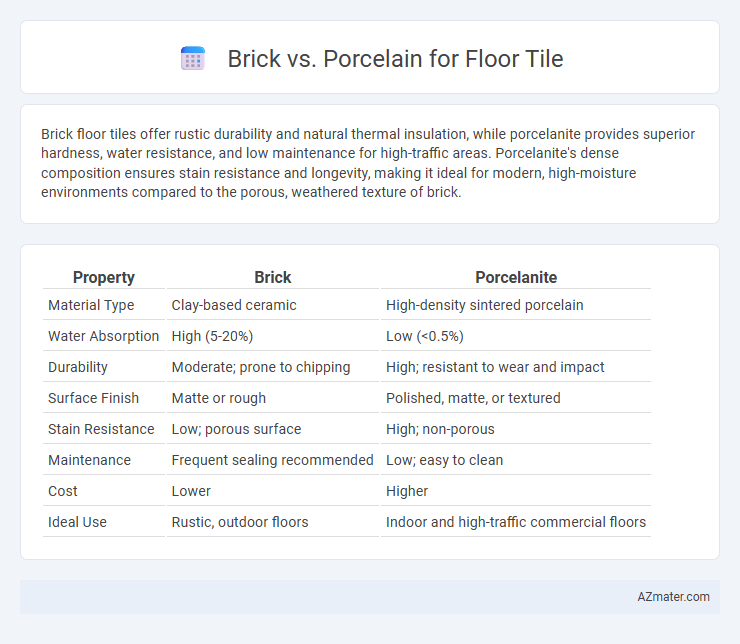Brick floor tiles offer rustic durability and natural thermal insulation, while porcelanite provides superior hardness, water resistance, and low maintenance for high-traffic areas. Porcelanite's dense composition ensures stain resistance and longevity, making it ideal for modern, high-moisture environments compared to the porous, weathered texture of brick.
Table of Comparison
| Property | Brick | Porcelanite |
|---|---|---|
| Material Type | Clay-based ceramic | High-density sintered porcelain |
| Water Absorption | High (5-20%) | Low (<0.5%) |
| Durability | Moderate; prone to chipping | High; resistant to wear and impact |
| Surface Finish | Matte or rough | Polished, matte, or textured |
| Stain Resistance | Low; porous surface | High; non-porous |
| Maintenance | Frequent sealing recommended | Low; easy to clean |
| Cost | Lower | Higher |
| Ideal Use | Rustic, outdoor floors | Indoor and high-traffic commercial floors |
Introduction: Brick vs Porcelanite Floor Tiles
Brick floor tiles offer a rustic aesthetic with natural texture and excellent durability, ideal for creating a warm, traditional ambiance. Porcelanite tiles provide a sleek, modern look with high resistance to moisture, stains, and wear, making them suitable for high-traffic and wet areas. Comparing brick and Porcelanite highlights differences in maintenance, water absorption, and design versatility essential for informed flooring choices.
Material Composition and Manufacturing
Brick tiles are primarily made from natural clay fired at high temperatures, resulting in a porous and dense material ideal for rustic and traditional flooring. Porcelanite tiles are manufactured using a vitrified process combining finely ground clays and feldspar, fired at extremely high temperatures to create a non-porous, highly durable surface. The distinct composition and firing techniques influence their durability, moisture resistance, and suitability for various floor applications.
Durability and Lifespan Comparison
Porcelanite tiles offer superior durability compared to brick, featuring a denser, less porous composition that resists cracking, chipping, and moisture damage, making them ideal for high-traffic areas. Brick tiles, while robust and weather-resistant, tend to wear down and develop surface imperfections over time due to their natural porous structure. The lifespan of Porcelanite flooring typically exceeds 50 years with minimal maintenance, whereas brick floors may require sealing or repairs every 10 to 20 years to maintain structural integrity.
Aesthetic Appeal and Design Options
Brick floor tiles offer a rustic, warm aesthetic ideal for traditional and industrial designs, featuring natural textures with earthy tones that add character and authenticity to spaces. Porcelanite tiles provide sleek, modern aesthetics with a wide array of colors, finishes, and patterns, including glossy, matte, and stone-like appearances that cater to contemporary and minimalist styles. The versatility in design options makes porcelanite suitable for high-end, custom layouts, while brick appeals to those seeking a durable yet timeless look.
Installation Process and Complexity
Brick flooring installation involves laying individual brick units using mortar, requiring precise alignment and substantial curing time, making it labor-intensive and suitable for skilled masons. Porcelanite tiles, produced through advanced pressing and firing techniques, offer a more uniform surface and simpler installation using thin-set adhesives, allowing quicker setting and less complex leveling. The complexity of brick installation stems from its irregular shapes and weight, while porcelanite tiles provide ease of handling and faster project completion.
Maintenance and Cleaning Requirements
Brick floor tiles require regular sealing to prevent staining and moisture absorption, as their porous surface is more prone to dirt buildup. Porcelanite tiles, made from dense porcelain, offer low-maintenance benefits with high resistance to stains, scratches, and water, making them easier to clean with simple sweeping and mopping. Routine cleaning for brick demands more effort and specialized sealers, while Porcelanite can withstand harsher cleaning agents and less frequent upkeep without compromising durability.
Cost Analysis: Budget and Value
Brick floor tiles generally offer a lower initial cost, making them a budget-friendly option for large-scale projects, but they may require more maintenance over time due to porosity and susceptibility to wear. Porcelanite tiles, while typically higher in upfront cost, provide superior durability, stain resistance, and low maintenance, delivering long-term value and reduced replacement expenses. Evaluating total cost of ownership reveals porcelanite's advantage in minimizing lifecycle costs despite a higher initial investment compared to brick.
Environmental Impact and Sustainability
Brick floor tiles are made from natural clay, fired at high temperatures, which results in a product with lower embodied energy compared to porcelanite tiles that require more intensive manufacturing processes and raw materials. Porcelanite tiles, often composed of refined porcelain or ceramic, offer greater durability and water resistance, extending their lifecycle and reducing replacement frequency, thereby positively impacting sustainability. However, brick tiles have better breathability and are more biodegradable at the end of their lifecycle, making them a more environmentally friendly option in terms of natural material usage and disposal.
Slip Resistance and Safety Features
Porcelanite floor tiles typically offer higher slip resistance compared to traditional brick due to their smoother, dense surface combined with advanced anti-slip coatings, making them ideal for wet or high-traffic areas. Brick tiles, while naturally textured, can become slippery when wet and may require additional surface treatments to improve safety. Selecting porcelain tiles with an R-factor rating of R10 or higher ensures compliance with slip resistance standards, enhancing overall floor safety.
Best Applications: Where Each Tile Excels
Brick floor tiles excel in outdoor patios, walkways, and rustic indoor spaces due to their natural texture, durability, and slip resistance. Porcelanite tiles perform best in high-traffic indoor areas such as kitchens, bathrooms, and commercial spaces, offering superior water resistance, low porosity, and easy maintenance. Porcelanite's wide range of colors and finishes suits modern aesthetics, while brick's earthy tones enhance traditional, industrial, and farmhouse designs.

Infographic: Brick vs Porcelanite for Floor Tile
 azmater.com
azmater.com